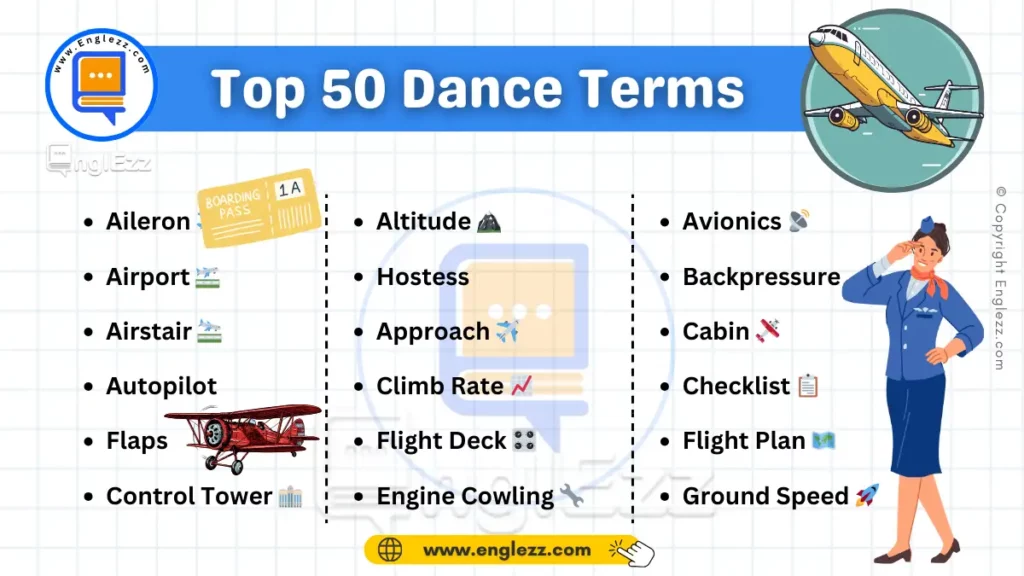Mastering aviation terminology is more than just memorizing words—it’s about understanding their application and importance in the aviation industry. This guide to the 50 most common aviation English terms equips you with the knowledge needed to navigate the skies with confidence.
From the role of the autopilot to the significance of the jet stream, each term plays a vital part in the operations and communication within aviation.
Table of Contents
- 50 Aviation English Terms Every Student Must Know
- #1. Altimeter 🛫
- #2. ATC (Air Traffic Control) 🗣️
- #3. Fuselage ✈️
- #4. Wing Flaps 🦋
- #5. Cockpit 🧑✈️
- #6. Jet Stream 🌬️
- #7. VOR (VHF Omnidirectional Range) 📡
- #8. Aileron 🛬
- #9. Runway 🛤️
- #10. Turbulence 🌪️
- #11. Elevators 🚀
- #12. Autopilot 🤖
- #13. Altitude 🏔️
- #14. Terminal 🚉
- #15. Landing Gear 🛬
- #16. Crosswind 🌬️
- #17. Radar 📡
- #18. Black Box 📦
- #19. Jet Engine ✈️
- #20. IFR (Instrument Flight Rules) 📜
- #21. VFR (Visual Flight Rules) 🏞️
- #22. Throttle 🕹️
- #23. Turboprop ✈️
- #24. Control Tower 🏢
- #25. Flight Plan 🗺️
- #26. Navigation 📍
- #27. Winglet 🌟
- #28. Avionics 📡
- #29. Flight Attendant ✈️
- #30. Pilot ✈️
- #31. Taxiway 🚖
- #32. Airspeed 📈
- #33. Flaps 📜
- #34. Checklist 📋
- #35. Cabin ✈️
- #36. Holding Pattern 🌀
- #37. Aircraft 🚀
- #38. Speed Brakes 🛑
- #39. Climb Rate 📈
- #40. Flight Deck 🎛️
- #41. Emergency Exit 🚪
- #42. Propeller 🌀
- #43. Radar Altimeter 📡
- #44. Engine Cowling 🔧
- #45. Air Traffic Controller 🎙️
- #46. Ground Speed 🚀
- #47. Instrument Panel 🎛️
- #48. Flight Path 🌍
- #49. Autopilot 🤖
- #50. Jet Stream 🌬️
- Aviation English Terms Table
- Conclusion
50 Aviation English Terms Every Student Must Know
Whether you’re preparing for a career in aviation or simply looking to expand your vocabulary, these definitions and examples will serve as a valuable resource. Stay informed, stay safe, and keep flying high with your enhanced aviation vocabulary!
#1. Altimeter 🛫
Definition: A device used to measure altitude by comparing atmospheric pressure to a standard.
Phonetic Transcription: /ˈæltɪˌmiːtər/
Examples:
- The pilot checked the altimeter to ensure the aircraft was flying at the correct cruising altitude.
- Changes in weather can affect the altimeter reading, so pilots need to adjust it frequently.
#2. ATC (Air Traffic Control) 🗣️
Definition: A service provided to prevent collisions between aircraft and to manage air traffic.
Phonetic Transcription: /eɪ tiː siː/
Examples:
- The pilot communicated with ATC for clearance before taking off.
- ATC directs aircraft during their descent and landing phases to ensure safe spacing.
#3. Fuselage ✈️
Definition: The main body of an aircraft, where passengers and cargo are housed.
Phonetic Transcription: /ˈfjʊˌzɪlɑːʒ/
Examples:
- The fuselage of the airplane was designed to be aerodynamic for better fuel efficiency.
- Maintenance crews inspect the fuselage regularly for any signs of wear or damage.
#4. Wing Flaps 🦋
Definition: Moveable panels on the wings that increase lift and drag during takeoff and landing.
Phonetic Transcription: /wɪŋ flæps/
Examples:
- The pilot extended the wing flaps to increase lift during the takeoff roll.
- Adjusting the wing flaps correctly is crucial for a smooth landing.
#5. Cockpit 🧑✈️
Definition: The area of the aircraft where the pilots sit and control the plane.
Phonetic Transcription: /ˈkɒkpɪt/
Examples:
- The cockpit is equipped with various instruments and controls essential for flying.
- Pilots spend most of their time in the cockpit during a flight.
#6. Jet Stream 🌬️
Definition: A fast-flowing ribbon of air found in the upper atmosphere.
Phonetic Transcription: /dʒɛt striːm/
Examples:
- The aircraft took advantage of the jet stream to reduce fuel consumption.
- Turbulence can occur when flying in or near a jet stream.
#7. VOR (VHF Omnidirectional Range) 📡
Definition: A type of radio navigation system for aircraft.
Phonetic Transcription: /ˌviː eɪtʃ ˈoʊmniˈdɪrɛkʃənəl reɪndʒ/
Examples:
- Pilots use the VOR to determine their position relative to a navigation beacon.
- The VOR system helps in maintaining accurate flight paths.

#8. Aileron 🛬
Definition: A hinged flight control surface on the wing that controls roll.
Phonetic Transcription: /ˈeɪlərɒn/
Examples:
- The pilot adjusted the ailerons to stabilize the aircraft during turbulence.
- Ailerons are crucial for making bank turns in flight.
#9. Runway 🛤️
Definition: A designated area on an airport where aircraft take off and land.
Phonetic Transcription: /ˈrʌnweɪ/
Examples:
- The plane touched down on runway 27 after a smooth landing.
- Runway maintenance is essential for ensuring safe takeoffs and landings.
#10. Turbulence 🌪️
Definition: Irregular motion of the air resulting in bumpy flight conditions.
Phonetic Transcription: /ˈtɜːrbjələns/
Examples:
- The flight experienced turbulence as it passed through a storm system.
- Pilots often adjust altitude to find smoother air during turbulence.
#11. Elevators 🚀
Definition: Control surfaces on the tail of an aircraft that control pitch.
Phonetic Transcription: /ˈɛlɪˌveɪtəz/
Examples:
- Adjusting the elevators helps the pilot climb or descend.
- Proper elevator control is critical for maintaining level flight.
#12. Autopilot 🤖
Definition: A system that automatically controls the aircraft’s flight path.
Phonetic Transcription: /ˈɔːtoʊˌpaɪlət/
Examples:
- The pilot engaged the autopilot to manage the aircraft during long flights.
- Autopilot systems can be programmed to follow specific routes and altitudes.
#13. Altitude 🏔️
Definition: The height of an aircraft above a specific reference point, usually sea level.
Phonetic Transcription: /ˈæltɪˌtjud/
Examples:
- The aircraft maintained an altitude of 35,000 feet for the duration of the flight.
- Pilots must adjust altitude to avoid other aircraft and weather disturbances.
#14. Terminal 🚉
Definition: The building at an airport where passengers board and disembark from flights.
Phonetic Transcription: /ˈtɜːrmɪnəl/
Examples:
- Passengers waited in the terminal for their flight’s boarding announcement.
- The terminal houses ticket counters, baggage claim, and security checkpoints.
#15. Landing Gear 🛬
Definition: The wheels or skids of an aircraft used for landing and taking off.
Phonetic Transcription: /ˈlændɪŋ ɡɪər/
Examples:
- The pilot deployed the landing gear before initiating the descent.
- Inspecting the landing gear is a crucial part of pre-flight checks.
#16. Crosswind 🌬️
Definition: Wind blowing perpendicular to the direction of an aircraft’s path.
Phonetic Transcription: /ˈkrɔːs wɪnd/
Examples:
- The pilot adjusted for crosswind conditions during the landing approach.
- Crosswind landings require careful control to maintain the aircraft’s alignment with the runway.
#17. Radar 📡
Definition: A system that uses radio waves to detect and track aircraft.
Phonetic Transcription: /ˈreɪdɑːr/
Examples:
- Air traffic controllers use radar to monitor the positions of aircraft.
- Radar systems help pilots avoid collisions by providing real-time traffic information.
#18. Black Box 📦
Definition: A flight data recorder that stores information about the aircraft’s performance and cockpit conversations.
Phonetic Transcription: /blæk bɒks/
Examples:
- The black box was crucial in investigating the cause of the aviation incident.
- Flight data from the black box helps in improving aircraft safety.
#19. Jet Engine ✈️
Definition: A type of engine that propels aircraft by expelling jet streams of air.
Phonetic Transcription: /dʒɛt ˈɛn(d)ʒɪn/
Examples:
- Jet engines are commonly used in commercial airliners for their efficiency and power.
- Regular maintenance of the jet engine is essential for safe flight operations.
#20. IFR (Instrument Flight Rules) 📜
Definition: Regulations for flying using instruments when visibility is poor.
Phonetic Transcription: /ˈaɪ ɛf ɑːr/
Examples:
- The pilot filed an IFR flight plan due to foggy conditions.
- IFR training is essential for pilots who fly in low visibility conditions.
#21. VFR (Visual Flight Rules) 🏞️
Definition: Regulations for flying with visual reference to the ground and other landmarks.
Phonetic Transcription: /ˌviː ɛf ˈɑːr/
Examples:
- The pilot chose VFR conditions to navigate using visual landmarks.
- VFR is typically used in good weather when visibility is clear.
#22. Throttle 🕹️
Definition: A control used to regulate the engine’s power output.
Phonetic Transcription: /ˈθrɒtəl/
Examples:
- The pilot adjusted the throttle to increase speed during takeoff.
- Managing the throttle is crucial for maintaining the desired flight performance.
#23. Turboprop ✈️
Definition: An engine that combines a turbine with a propeller to drive the aircraft.
Phonetic Transcription: /ˈtɜːrboʊˌprɒp/
Examples:
- Turboprop engines are used in smaller regional aircraft for their efficiency.
- The pilot used the turboprop engine to power the aircraft during climb-out.
#24. Control Tower 🏢
Definition: The facility at an airport that manages air traffic control operations.
Phonetic Transcription: /kənˈtroʊl ˈtaʊər/
Examples:
- The control tower directed the aircraft for a safe landing sequence.
- Air traffic controllers in the control tower coordinate takeoffs and landings.
#25. Flight Plan 🗺️
Definition: A document filed by pilots outlining the intended route and flight details.
Phonetic Transcription: /flaɪt plæn/
Examples:
- The pilot submitted the flight plan before departure for air traffic control approval.
- A detailed flight plan helps ensure a safe and efficient journey.
Definition: The process of planning and controlling an aircraft’s route.
Phonetic Transcription: /ˌnævɪˈɡeɪʃən/
Examples:
- Accurate navigation is essential for reaching the destination safely.
- Pilots use various tools and instruments for precise navigation during flight.
#27. Winglet 🌟
Definition: A small, vertical wing-like structure at the end of an aircraft’s wing to improve efficiency.
Phonetic Transcription: /ˈwɪŋlɛt/
Examples:
- Winglets help reduce drag and improve fuel efficiency.
- Modern aircraft are often equipped with winglets to enhance performance.
#28. Avionics 📡
Definition: The electronic systems used in aircraft for navigation, communication, and monitoring.
Phonetic Transcription: /ˌeɪviˈɒnɪks/
Examples:
- Avionics systems include radar, GPS, and communication tools.
- Regular updates to avionics software ensure reliable aircraft operations.
#29. Flight Attendant ✈️
Definition: A crew member responsible for passenger safety and service during a flight.
Phonetic Transcription: /flaɪt əˈtɛndənt/
Examples:
- The flight attendant provided safety instructions before takeoff.
- Flight attendants assist passengers with boarding and in-flight needs.
#30. Pilot ✈️
Definition: A person who operates and controls an aircraft.
Phonetic Transcription: /ˈpaɪlət/
Examples:
- The pilot conducted a pre-flight check before taking off.
- Pilots undergo rigorous training to handle various flight conditions.
#31. Taxiway 🚖
Definition: A path on an airport used for moving aircraft between runways and terminals.
Phonetic Transcription: /ˈtæksiweɪ/
Examples:
- The aircraft followed the taxiway to reach the runway for takeoff.
- Taxiways are marked with signs and lights to guide pilots.
#32. Airspeed 📈
Definition: The speed of an aircraft relative to the air through which it is moving.
Phonetic Transcription: /ˈɛərspiːd/
Examples:
- Monitoring airspeed is crucial for maintaining safe flight conditions.
- The pilot adjusted the airspeed to optimize fuel consumption during the flight.
#33. Flaps 📜
Definition: Moveable surfaces on the wings that increase lift and drag.
Phonetic Transcription: /flæps/
Examples:
- Deploying the flaps allows for a shorter landing distance.
- Flaps are adjusted during takeoff and landing to enhance aircraft performance.
#34. Checklist 📋
Definition: A list of tasks or items to be verified before, during, or after flight.
Phonetic Transcription: /ˈʧɛklɪst/
Examples:
- The pilot used a checklist to ensure all pre-flight procedures were completed.
- Checklists help maintain consistency and safety in flight operations.
#35. Cabin ✈️
Definition: The interior of an aircraft where passengers are seated.
Phonetic Transcription: /ˈkæbɪn/
Examples:
- The cabin crew ensured the cabin was secure before takeoff.
- Cabin comfort is a key consideration for passenger satisfaction.
#36. Holding Pattern 🌀
Definition: A predetermined flight path used while waiting for clearance to land.
Phonetic Transcription: /ˈhoʊldɪŋ ˈpætərn/
Examples:
- The aircraft entered a holding pattern due to congestion at the airport.
- Holding patterns help manage air traffic and prevent collisions.
#37. Aircraft 🚀
Definition: A vehicle capable of flight, including airplanes, helicopters, and drones.
Phonetic Transcription: /ˈɛərkræft/
Examples:
- The aircraft performed a smooth takeoff from the runway.
- Various types of aircraft serve different purposes in aviation.
#38. Speed Brakes 🛑
Definition: Devices used to slow down an aircraft during descent or landing.
Phonetic Transcription: /spiːd breɪks/
Examples:
- The pilot deployed the speed brakes to reduce the aircraft’s speed before landing.
- Speed brakes are crucial for maintaining control during rapid descents.
#39. Climb Rate 📈
Definition: The rate at which an aircraft gains altitude.
Phonetic Transcription: /klaɪm reɪt/
Examples:
- The aircraft’s climb rate was adjusted for optimal ascent performance.
- Monitoring climb rate helps ensure the aircraft achieves the desired altitude efficiently.
#40. Flight Deck 🎛️
Definition: Another term for the cockpit, where the pilot controls the aircraft.
Phonetic Transcription: /flaɪt dɛk/
Examples:
- The flight deck is equipped with all the necessary controls and instruments for piloting.
- Pilots refer to the flight deck during all phases of flight.
#41. Emergency Exit 🚪
Definition: An exit used for quick evacuation in case of an emergency.
Phonetic Transcription: /ɪˈmɜːrdʒənsi ˈɛksɪt/
Examples:
- Passengers are instructed on the use of emergency exits during the safety briefing.
- Emergency exits are clearly marked and accessible in the aircraft cabin.
#42. Propeller 🌀
Definition: A rotating blade that provides thrust to propel the aircraft.
Phonetic Transcription: /prəˈpɛlər/
Examples:
- The propeller’s rotation creates the thrust needed for flight.
- Pilots monitor the propeller’s performance to ensure efficient operation.
#43. Radar Altimeter 📡
Definition: An instrument that measures altitude above the ground using radar signals.
Phonetic Transcription: /ˈreɪdɑːr æltɪˌmiːtər/
Examples:
- The radar altimeter provides precise altitude readings during landing.
- Radar altimeters are used for low-altitude flight operations and approach phases.
#44. Engine Cowling 🔧
Definition: A cover that surrounds an aircraft engine to protect and streamline airflow.
Phonetic Transcription: /ˈɛn(d)ʒɪn ˈkaʊlɪŋ/
Examples:
- The engine cowling must be inspected for damage before each flight.
- Proper maintenance of the engine cowling ensures optimal engine performance.
#45. Air Traffic Controller 🎙️
Definition: A person responsible for directing aircraft and ensuring safe air traffic operations.
Phonetic Transcription: /ɛər ˈtræfɪk kənˈtroʊlər/
Examples:
- The air traffic controller provided clearance for the aircraft’s takeoff.
- Air traffic controllers coordinate with pilots to manage airspace safely.
#46. Ground Speed 🚀
Definition: The speed of an aircraft relative to the ground.
Phonetic Transcription: /ɡraʊnd spiːd/
Examples:
- Ground speed is monitored to determine the aircraft’s actual speed over the Earth’s surface.
- Differences between airspeed and ground speed can occur due to wind conditions.
#47. Instrument Panel 🎛️
Definition: The dashboard in the cockpit displaying critical flight instruments.
Phonetic Transcription: /ˈɪnstrʊmənt ˈpænəl/
Examples:
- The instrument panel provides the pilot with real-time flight data.
- Pilots rely on the instrument panel for monitoring aircraft performance.
#48. Flight Path 🌍
Definition: The route followed by an aircraft during flight.
Phonetic Transcription: /flaɪt pæθ/
Examples:
- The flight path is planned based on weather conditions and air traffic.
- Pilots adjust the flight path to avoid obstacles and
#49. Autopilot 🤖
Definition: A system that automatically controls the aircraft’s flight path.
Phonetic Transcription: /ˈɔːtoʊˌpaɪlət/
Examples:
- The autopilot was engaged to maintain a steady course during long flights.
- Pilots can override the autopilot system when manual control is required.
#50. Jet Stream 🌬️
Definition: A high-altitude, fast-moving air current that affects aircraft performance.
Phonetic Transcription: /dʒɛt striːm/
Examples:
- Jet streams can significantly impact flight times and fuel efficiency.
- Pilots use information about jet streams to plan optimal flight routes.
Aviation English Terms Table
| Aileron ✈️ | Altitude 🏔️ | Avionics 📡 |
| Airport 🛫 | Hostess | Backpressure 🚦 |
| Airstair 🛬 | Approach ✈️ | Cabin 🛩️ |
| Autopilot 🤖 | Climb Rate 📈 | Checklist 📋 |
| Flaps 📜 | Flight Deck 🎛️ | Flight Plan 🗺️ |
| Control Tower 🏢 | Engine Cowling 🔧 | Ground Speed 🚀 |
| Jet Stream 🌬️ | Holding Pattern 🌀 | Instrument Panel 🎛️ |
| Navigation 📍 | Propeller 🌀 | Radar Altimeter 📡 |
| Speed Brakes 🛑 | Throttle 🕹️ | Turboprop ✈️ |
| Winglet 🌟 | Flight Attendant ✈️ | Pilot ✈️ |
Conclusion
Mastering aviation terminology is more than just memorizing words — it’s about understanding their application and importance in the aviation industry. This guide to the 50 most common aviation English terms equips you with the knowledge needed to navigate the skies with confidence.
https://www.eytravels.com/financeFrom the role of the autopilot to the significance of the jet stream, each term plays a vital part in the operations and communication within aviation. Whether you’re preparing for a career in aviation or simply looking to expand your vocabulary, these definitions and examples will serve as a valuable resource.
Stay informed, stay safe, and keep flying high with your enhanced aviation vocabulary!









Ready to soar into the world of aviation? ✈️ Discover essential aviation English terms with clear definitions and practical examples to boost your knowledge. Don’t miss out—follow @EnglEzz for more insightful content and tips! 🚀For a complete guide, check it out here:
http://www.englezz.com/?p=19524
.
#EnglEzz #Vocabulary #Linguistics #LearnEnglish #Aviation #PilotLife #FlightTraining #AviationTerms #SkyHigh
Just wish to say your article is as surprising! The clearness in your post is just cool and I could assume you’re an expert on this subject Fine with your permission allow me to grab your RSS feed to keep updated with forthcoming post Thanks a million and please keep up the enjoyable work! 🙂